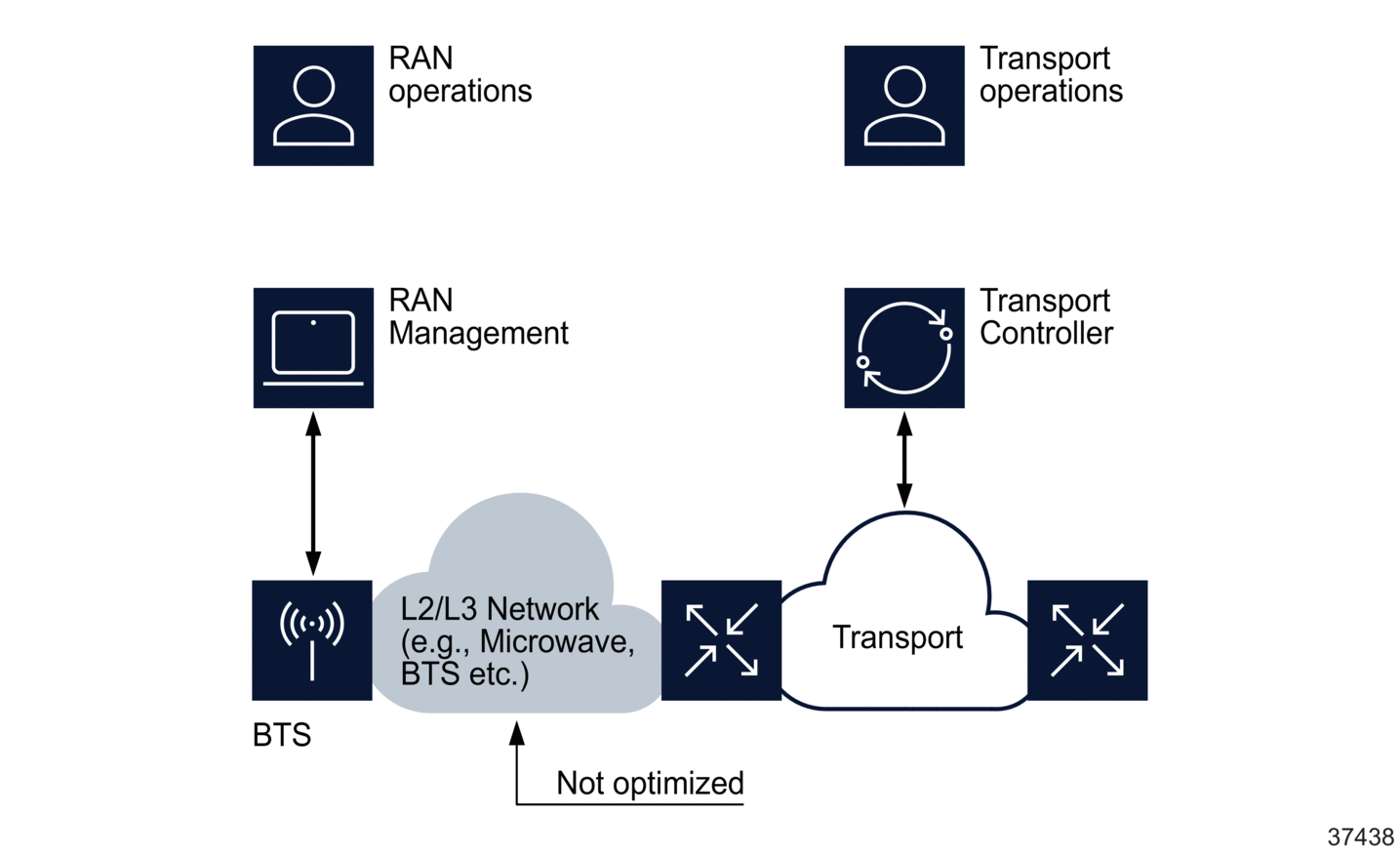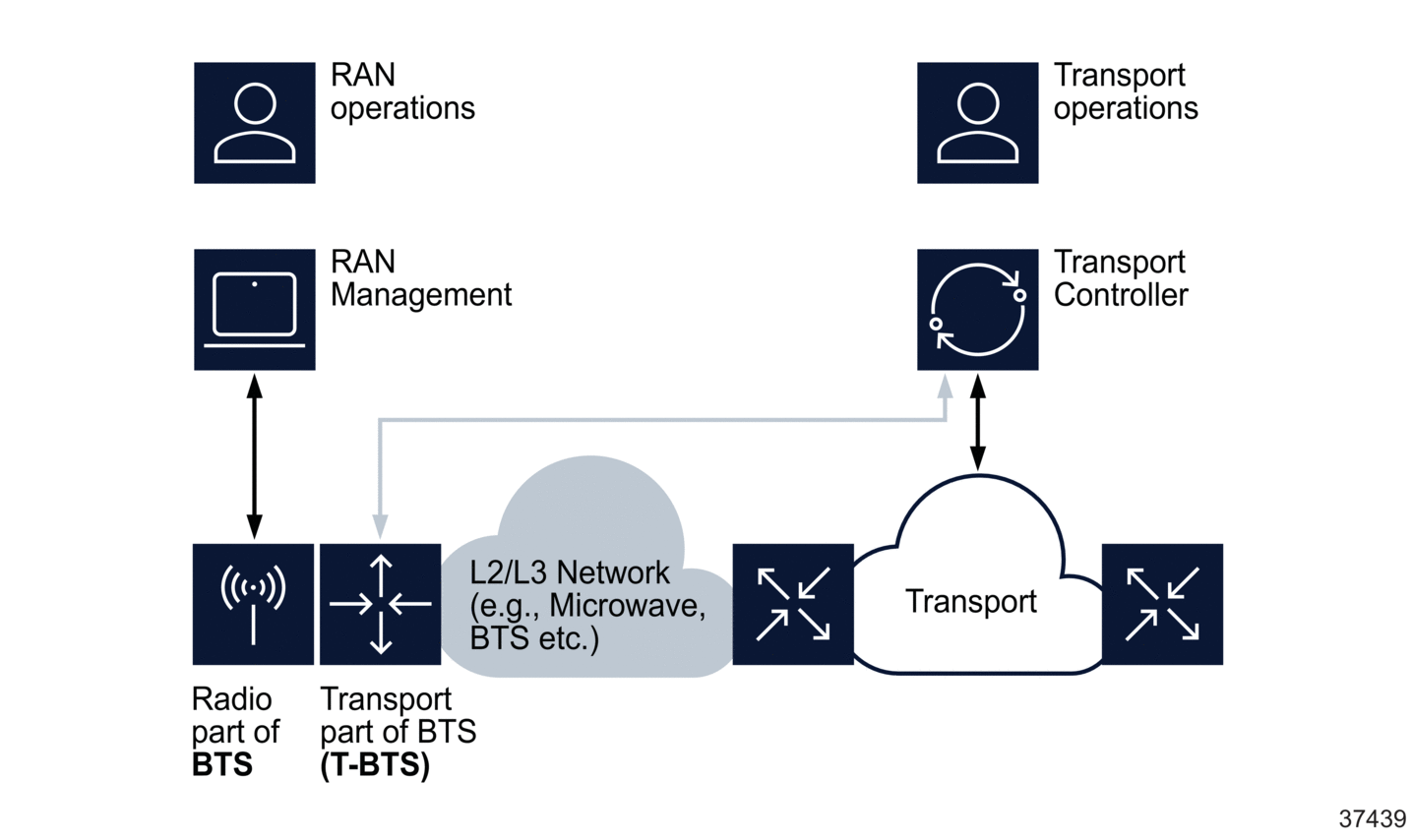What is Simplified RAN Transport?
Consider the following issues in the traditional RAN management process:
-
Operations teams are split into separate departments to manage the RAN and transport domains. Each team is responsible for provisioning, monitoring, and maintenance for their respective domain. See Figure 1-1, Present mode of operation for managing RAN and transport domains.
-
Transport provisioning across the RAN/transport boundary requires provisioning alignment, but is typically managed via offline processes and tools leading to double effort, error prone procedures, and longer lead time. Impact and fault analysis require additional time to identify root causes since troubleshooting procedures and data coordination must be implemented across more than one team.
-
Transport parameters (VLAN/IP, QoS) must be configured twice via RAN and transport controllers. This presents double the effort and manual alignment of offline tools, along with an increases risk of errors.
Evolution to 5G with a RAN enabled for network slicing presents additional complexity that requires automation between the RAN and transport domains. The dynamic nature of network slicing leads to an exponential increase in OPEX.
Figure 1-1: Present mode of operation for managing RAN and transport domains
NSP Simplified RAN Transport Solution
The NSP Simplified RAN Transport (SRT) solution streamlines the configuration of transport parameters by extending the transport domain to the RAN through management of the Transport BTS (T-BTS). SRT uses the existing RAN management functions of NetAct/MantaRay NM as a mediation layer to provide discovery, provisioning, fault management, and performance management for the T-BTS. Specifically, SRT provides a means to manage T-BTS transport features and radio plane (VLAN-based independent network layer) bindings to IP transport services in 3G, 4G, and 5G networks, in addition to easy access to T-BTS transport parameter configurations. See Figure 1-2, Enhance transport automation capabilities across the entire mobile network using SRT.
SRT provides the following benefits:
-
logical disaggregation of the transport portion of the T-BTS and manages the T-BTS as SDN controller via NetAct/MantaRay NM mediation
-
use of the existing RAN management functions of NetAct/MantaRay NM as mediation to NSP and management of T-BTS logical nodes via NetAct/MantaRay NM
-
extension of the transport domain to the T-BTS, simplifying mobile transport provisioning and enhancing service and network assurance (FM and PM)
-
using SRT, the operations team can access T-BTS transport parameters for configuration checks and troubleshooting
-
transport capabilities previously used by the transport operations team can be brought to the RAN transport domain
Figure 1-2: Enhance transport automation capabilities across the entire mobile network using SRT
Through NSP, SRT is aware of the L2 links between BTS and PE routers through the shared VLAN connection. Direct connections and microwave (Wavence) between the BTS and the transport network are supported. These topology elements are automatically updated on discovery, configuration change, and deletion via LLDP. In cases where LLDP is not supported by the node, the link can be manually created.
What are radio planes?
Radio planes are sources of network packets coming from the radio components of the T-BTS. One of the primary functions of SRT is to compute the "Binding State" for all radio planes on the T-BTS; a radio plane is considered "bound" to a given L3 VPN SAP on a mobile core router when the configuration (VLAN/IP/routes) on the T-BTS allows network traffic generated by the radio plane to reach the L3 VPN SAP by traversing the L2 backhaul network.
On NSP systems with SRT installed, radio plane binding information exists in a dedicated panel and table displayed in the Network Map and Health view called Radio Plane Bindings. SRT allows operators to perform a binding action on a given radio plane on the T-BTS, connecting the radio plane to a selected L3 VPN on the mobile core network. This is performed using a Workflow template that can be launched directly from the Radio Plane Bindings table.
See Radio plane bindings in SRT for more information about managing radio planes.
What other NSP functions are involved in managing RAN transport?
The following NSP functions are used for managing RAN transport:
-
Network Map and Health: viewing RAN transport equipment and bindings, viewing T-BTS in the network map view, creating radio plane bindings, viewing T-BTS nodes and their links (with highest alarm severity), BTS inventory, viewing and managing T-BTS alarms. See How do I view RAN transport equipment and bindings? and How do I perform link management? for more information.
See the NSP Network and Service Assurance Guide for information about troubleshooting using alarms.
-
Workflows: executing RAN bindings. See the NSP Network Automation Guide for more information.
-
Device Management: managing NetAct/MantaRay NM and T-BTS supervision. See the NSP Device Management Guide for more information.
-
Maps Layouts and Groups: creating views and supervision groups. See the NSP System Administrator Guide for more information.
Service Management provides the following capabilities:
-
The description for each L2 backhaul service displays the names of the T-BTS associated with the service. See How do I manage L2 backhaul services? for more information.
What are the use-cases for SRT?
The following are examples of use-cases for SRT.
Discovering the transport portion of 3G/4G/5G T-BTS in NSP
SRT provides the functionality to discover T-BTS as transport nodes in NSP and display them on the network map view. The links between T-BTS and the transport network are also displayed on the map, and are either dynamically discovered via LLDP or manually configured. The following functionality is also provided:
Links can be created manually. See the NSP Network and Service Assurance Guide for information about creating physical links.
Retrieving 3G/4G/5G T-BTS radio planes and correlating to transport services
In this context, the SRT is capable of:
-
retrieving and displaying all 3G/4G/5G radio planes, including relevant attributes and alarms
-
auditing all radio planes for active connections to transport services
In addition to displaying the bindings between radio planes and transport services (see Radio plane bindings in SRT), SRT provides functionality to create these bindings (see How do I bind a radio plane?). RAN services that exist in the context of a 4G/5G RAN slice are also available in Transport Slice Controller.
Leveraging 4G/5G network slicing full life cycle management
SRT provides the following end-to-end features:
-
extension of automation to 5G transport slices and transport RAN with full flexibility for any combination of resource (IP address, VLAN, QoS, and traffic identifiers) between RAN and transport
-
end-to-end monitoring, reporting, and alarm correlation for the T-BTS
-
extension of closed-loop automation of transport slices to T-BTS
Zero footprint microwave with BTS networking boost
SRT simplifies Wavence deployment by integrating L2 transport features at cell sites inside the BTS. SRT is capable of managing the binding status of radio planes for RAN and transport networks connected via Wavence nodes.
SRT support in Release 23.11
See the NSP NFM-P Network Element Compatibility Guide for information about:
See the NSP Nokia TBTS Adaptor Guide for information about:
Integration with NetAct/MantaRay NM
T-BTS are managed in NSP via NSP management of NetAct/MantaRay NM, which is managed through MDM adaptors. Through this, NSP can retrieve T-BTS nodes, RAN services, and associate the RAN services with transport services. T-BTS alarms are also retrieved from NetAct/MantaRay NM and displayed in NSP.
Note: Fault management for NetAct/MantaRay NM servers is not provided through NSP.

